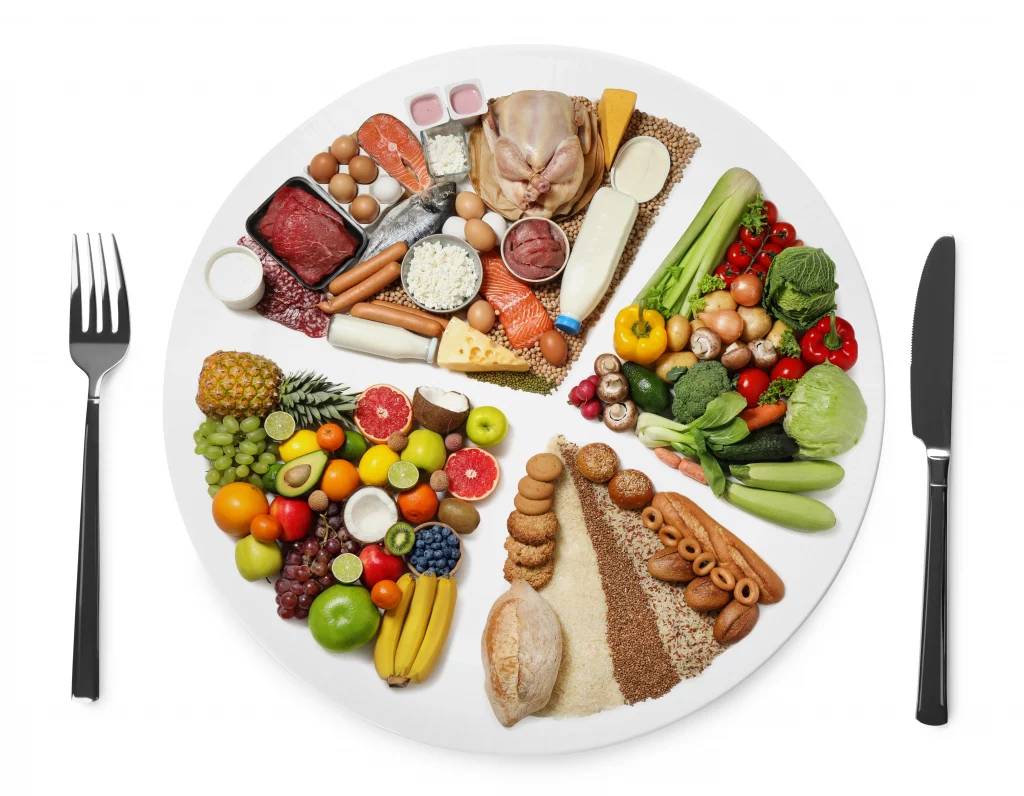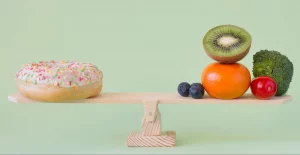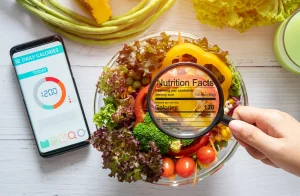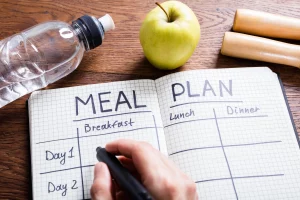Making healthier food choices is a crucial component of The 15 Day Challenge. We’ve received hundreds of testimonies indicating that people find it difficult to form nutritional habits, struggling with overeating, portion control, or the temptation of junk food and sugary snacks.
We’re here to help.
What should a healthy plate include? How much should you eat on a daily basis? How can you change up your routine to avoid overeating? Let’s break it down to the basics.

What does a healthy plate look like?
Daily portion recommendations vary from person to person based on a variety of factors. Your age, gender, weight, activity level, and other factors determine how many calories you should consume per day. The U.S. Department of Agriculture’s MyPlate initiative provides a tool to help you determine specifications for your meal plan!
The current Dietary Guidelines for Americans recommend portions based on calories. For example, a 2,000-calorie diet calls for these daily servings:
- 2 ½ cups of vegetables
- 2 cups of fruit
- 6 ounces of grains
- 5 ½ ounces of protein
- 3 cups of dairy
Each of these food groups is important for a healthy diet! Let’s break them down.

Fill half your plate with fruits and vegetables.
If you struggle to eat enough fruits and veggies, you’re not alone. A 2015 survey found that only 9% of adults consumed enough vegetables, and just 12% ate enough fruits. But these two food groups are an essential component of your diet!
Variety is key. Mix up the way you consume your fruits and veggies. Whether you snack on raw carrots, steam broccoli for your dinner, cut up an apple, or add a can of pineapple chunks to your breakfast, any fruit and vegetable content is valuable when it comes to improving your diet! Even 100% fruit juice counts, though at least half of your fruit consumption should come from whole fruits.
Studies have shown that the consumption of fruits and vegetables is associated with physical and mental benefits. A higher intake of these two food groups has been linked to a reduced risk of diseases, such as cancer and cardiovascular disease, as well as a lower likelihood of premature death.
Another study found that those who ate more fruits and veggies felt happier, showed more creativity and curiosity, experienced more satisfaction with their lives, and reported less stress.
(Several fruits and vegetables are believed to have mood-boosting qualities. You can read about a few of those here!)

Grains should make up a quarter of your plate.
This food group includes wheat, oats, rice, and pasta, among other foods.
When choosing your grains, remember that whole grains are preferable to refined grains! Foods that retain their entire grain kernel, such as whole-wheat flour or brown rice, contain vitamins and nutrients that are lost in the milling process that creates refined grains, such as white bread or white rice. Plus, whole grains affect your blood sugar and insulin levels less than refined grains!
Grains supply dietary fiber, which can support healthy bowel movements, help lower your cholesterol, or even reduce your risk of heart disease! Grains also contain B vitamins, which can boost your metabolism, iron, which carries oxygen through your bloodstream, and magnesium, which supports your bones!

Pack the rest of your plate with protein.
Fill the last quarter of your plate with protein! This food group includes meat, seafood, eggs, nuts, and seeds. MyPlate suggests consuming lean or low-fat meats and limiting your consumption of red meat!
This food group also includes beans, peas, and lentils, which have qualities of vegetables and proteins, providing your body with fiber, potassium, iron, and zinc!
Protein is essential for strengthening your bones and muscles, supporting your skin and blood, and consuming the vitamins your body needs!

Don’t forget dairy!
Unfortunately, it is not recommended that you fulfill your daily dairy recommendation with ice cream, cake, or other dairy-based desserts. Instead, opt for low-fat or fat-free cheese, milk, or yogurt!
Dairy-based liquids, such as milk or cream, should be consumed in moderation. Opt for a glass of milk with dinner or a fruit-packed yogurt breakfast!
Do you struggle with portion control?
We’ve all been there. We’ve all seen the massive amounts of food that restaurants pack onto a plate, had a late-night snacking session, or scraped the bottom of a chip bag without realizing how much we’ve been consuming.
It’s a simple, proven fact that when people are presented with larger portions, they will eat more. But practicing portion control is vital to pursuing a healthy diet.
Portion control helps your body digest food, which is vital to maintaining or losing weight, and helps you avoid the sluggishness you feel after eating a big meal, supplying your body with energy throughout the day.
Here are five practical tips to help you practice portion control!
1. Choose healthier snacks.

Contrary to popular assumption, snacking isn’t bad for you. In fact, snacking can help you feel more full throughout the day and keep you from overeating during meals! The key is replacing calorie-loaded, highly processed foods with healthier options.
If you’re feeling hungry, snack on nutrient-rich foods like a slice of fruit, a pack of nuts, a hummus spread, or a salad packed with your favorite veggies. Try to stay away from snacks with added sugar or salt!
Choose healthier beverages, too! Milk, 100% fruit juice, or water are all better options than sugary sodas. (Want to learn more about healthy hydration? We have a blog for that!)

2. Avoid eating too late at night.
It’s easy to snack mindlessly. When you’re relaxing after a long day, watching TV or scrolling on your phone, your attention is diverted away from what you’re eating.
Registered dietician Alexis Supan recommends that you stop eating roughly three hours before you plan to sleep. When you consume calories without time to burn them off, your body stores those calories as fat, opening the door for weight gain.
Give your body enough time to digest food before you fall asleep! If you can’t suppress your hunger, try healthy snacks like nuts or a slice of fruit rather than a sugary dessert! Avoid coffee or alcohol; choose milk, tea, or water instead!
3. Keep a log of your meals.

Whether you use a virtual calorie tracker or write out a diary of your daily food consumption by hand, keeping track of what you’re eating can help you temper your diet.
Write down what you eat to ensure you’re meeting dietary recommendations and avoiding mindless eating. Keeping track of your foods can help you be more intentional when planning your meals and identify areas for improvement.
A 2019 study found that over six months, people who kept a log of what they ate lost up to 10 percent of their body weight! Use a calorie tracker for extra motivation to help you reach your goals!

4. Schedule your meals.
The power of meal-planning cannot be overstated. Amid a hectic schedule, finding time to eat can be difficult. Many people find themselves eating on the go, needing quick meals that can be consumed in the car or between meetings, which can be counterproductive to a healthy diet and weight-loss goals.
To avoid winding up in the drive-through for quick and convenient food, plan your meals in advance to grab and go when you leave for work in the morning or come home in the evening.
Schedule your meals to build consistency, adapt your body to intervals between meals, and give yourself the time to eat slowly. The slower you eat, the better your body digests food and the fuller you’ll feel in a shorter period!
5. Scale down your portion sizes!

In the United States in particular, serving sizes on packages and portions served at restaurants have increased drastically over the past few decades. In fact, The American Heart Association found that over four decades, Americans’ average daily calorie count has increased by roughly 300 calories.
Work around these hefty portions by splitting your meals. To scale down your portion sizes and save money on groceries, utilize leftovers! Eat only half of your meal at a restaurant and save the other half for another meal.
At home, try using smaller plates for meals. Instead of eating directly from a snack package, use small bowls to better visualize how much you’re consuming. Better yet, if you struggle to stay away from salty or sugary snacks, hide them at the back of your cabinet!
Creating a healthy plate begins with small steps.
Improving your diet doesn’t have to be torturous. Eating healthier doesn’t mean eliminating all treats or setting such a strict calorie limit for yourself that you feel like you’re starving.
Eating healthier means making an effort to include the necessary food groups to support your body. It means cutting down on junk food in lieu of more nutritious options. Nourish your body with a healthy plate as part of your next 15 Day Challenge!
By Morgan Brown, Creative Content Writer




Leave a comment
This site is protected by hCaptcha and the hCaptcha Privacy Policy and Terms of Service apply.